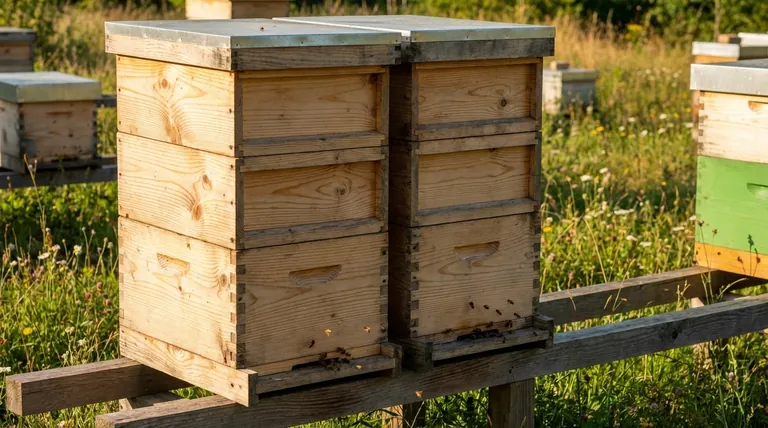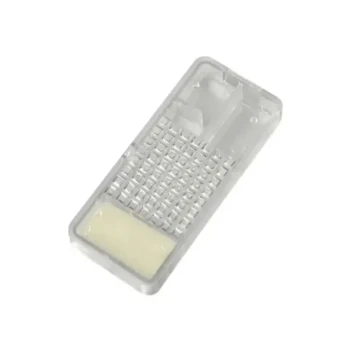To expand a double nuc, you vertically add a dedicated 4-frame super on top of each of the two colonies within the divided box. This method allows each nucleus colony to grow independently, turning a single shared box into two separate, multi-story hives. You can stack supers as high as needed, progressing from a 4-frame nuc to an 8-frame or even a 12-frame colony on each side.
The core principle is not just about adding space, but about leveraging the double nuc's flexibility. You are either building two separate, viable colonies in close proximity or preparing them to be united into a single powerhouse for maximum honey production.

Understanding the Double Nuc System
A double nuc, often called a "twin nuc" or "divided deep," is a standard 10-frame Langstroth box modified with a solid divider down the middle. This partition creates two independent 4-frame or 5-frame nucleus colony compartments within a single piece of equipment.
The Purpose of a Double Nuc
This system is highly efficient for beekeepers. It allows for raising two small colonies side-by-side, which is ideal for rearing new queens, overwintering smaller populations, or splitting a strong hive.
Key Components
The system relies on a few critical parts: a standard-sized outer box, a full-depth central divider, and separate entrances for each colony. The entrances must be on opposite sides of the box to prevent bees from drifting between the two hives.
The Expansion Process Explained
Expansion is driven by the colony's growth. Adding space at the right time prevents swarming and encourages the colony to build strength and store honey.
When to Add a Super
The trigger for adding a super is population density. When the bees have drawn out and are actively using 70-80% of the frames in their current box (e.g., 3 of 4 frames), it is time to add more space.
Adding the First Super (Creating an 8-Frame Colony)
Place a 4-frame super directly on top of one side of the double nuc box. Do the same for the other side. You now have two distinct 8-frame colonies (4 frames on the bottom, 4 on top) living next to each other.
A queen excluder can be placed between the bottom box and the new super if your goal is to dedicate the top box purely to honey storage.
Progressing to a 12-Frame Colony and Beyond
The process can be repeated. Once the bees have filled the second super, a third 4-frame super can be added on top. This creates a 12-frame colony on each side, providing significant space for brood and honey.
Strategic Trade-offs and Considerations
While efficient, the double nuc system requires careful management and an understanding of its unique characteristics.
Advantage: Thermal Efficiency
Two colonies sharing a box generate more combined heat than a single nuc. This shared warmth is a major advantage for successful overwintering and promotes a faster population buildup in the spring.
Advantage: Resource and Space Efficiency
You can manage two queens and two colonies using a minimal amount of woodenware. This is perfect for beekeepers with limited space or those focused on queen rearing operations.
Risk: Colony Imbalance and Drifting
If one colony becomes significantly stronger than its neighbor, it can begin to rob the weaker colony. Ensuring the entrances are far apart and clearly distinct is critical to minimize bees drifting from one hive to the other, which can exacerbate any imbalance.
Risk: Accidental Merging
A poorly fitting divider can allow bees, or even a queen, to cross over. This will inevitably lead to the two colonies fighting and merging into one, leaving you with a single queen. Regular inspection of the equipment is necessary.
Making the Right Choice for Your Goal
Your reason for using a double nuc will dictate your expansion strategy.
- If your primary focus is raising queens or overwintering nucs: Expand vertically with supers only when the bees become crowded, providing just enough space to prevent swarming.
- If your primary focus is moderate honey production from two hives: Add supers to both sides as they grow, managing them as two separate vertical hives for the entire season.
- If your primary focus is maximizing honey yield for a major flow: Build both colonies up, then unite them by removing one queen and the central divider a few weeks before the main honey flow begins.
The double nuc system is a versatile tool that empowers you to manage your colonies with remarkable precision and efficiency.
Summary Table:
| Expansion Step | Action | Result |
|---|---|---|
| Initial Setup | Two 4-frame colonies in a divided box. | Two independent nucs. |
| First Expansion | Add a 4-frame super to each side. | Two 8-frame colonies. |
| Further Growth | Continue adding supers as needed. | Colonies can grow to 12+ frames each. |
| Strategic Goal | Unite colonies before a honey flow. | One powerful, high-yield hive. |
Ready to scale your beekeeping operation with precision equipment?
At HONESTBEE, we specialize in supplying durable, high-quality beekeeping supplies and equipment to commercial apiaries and distributors. Our wholesale-focused operations ensure you get the reliable gear—like double nuc boxes, dividers, and supers—you need to manage colony growth efficiently and maximize your honey yield.
Contact our expert team today to discuss your specific needs and discover how our products can support your success.
Visual Guide

Related Products
- 5 Frame Wooden Nuc Box for Beekeeping
- Twin Queen Styrofoam Honey Bee Nucs Mating and Breeding Box
- Automatic Heat Preservation 6 Frame Pro Nuc Box for Honey Bee Queen Mating
- Plastic Transporting Bee Packages and Nuc Boxes for Beekeeping
- Styrofoam Mini Mating Nuc Box with Frames Feeder Styrofoam Bee Hives 3 Frame Nuc Box
People Also Ask
- What frames should be moved into the queenless hive when requeening with a nuc? Ensure a Successful Queen Introduction
- What is the advantage of overwintering a nucleus? A Strategic Asset for Beekeeping Success
- What are the benefits of starting a new bee colony in a nuc box? Boost Colony Success with Efficient Beekeeping
- What is the purpose of having a nuc in beekeeping? Build a Resilient & Productive Apiary
- What are the benefits of moving nuclei around the apiary? Master Strategic Hive Management



















